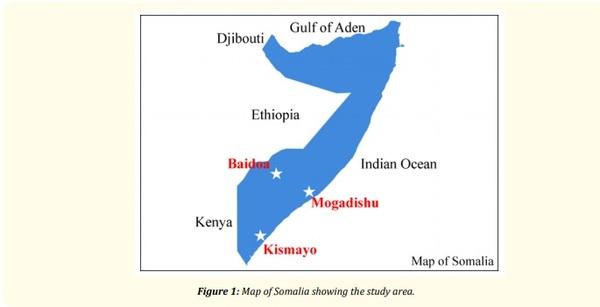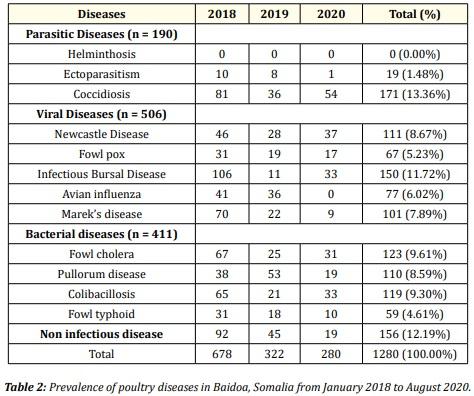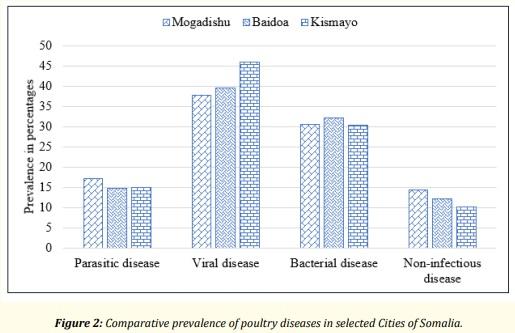Introduction
Poultry, also recognized as universal food, as poultry meat and eggs enjoy zero religious’ restrictions, unlike pork and beef [1]. Being universal and accepted by all religions, the demand of poultry increased globally hence the trend of rearing is also increased. Poultry meat and eggs are the main source of protein, household nutrition and income in developing countries [2]. In Somali economy, still the Livestock sector acts as a crucial component and becomes a backbone [3]. Like other countries, poultry production in Somalia is also an important component of the livestock sub-sector. Development of the poultry sub-sector contribute in income foreign currency, employment, food and nutrition security, and women’s economic employment in rural areas. In Somalia, Poultry keeping is widespread among poor households and now commercial poultry farming is also on the rise, particularly in urban areas [4].
Common poultry diseases available around the globe are fowl pox, Newcastle disease, infectious bronchitis, avian influenza, aspergillosis, Marek’s disease, infectious bursal disease, lymphoid leukosis, fowl cholera, omphalitis, pullorum, necrotic enteritis, ulcerative enteritis, Staphylococcus, Salmonella, Campylobacter [5].
Objective of the Study
The main objective of our study is to figure out the prevalence of commonly seen poultry diseases which cause economic loss to the small-scale farmers as well as commercial farms. As far as we know, no such report was published yet so we conduct this study which may help in developing control strategies to mitigate poultry diseases and formulating the policy at government level in future.
Materials and Methods
Study animal, population, period and location
A total of 4042 poultry (Gallus domesticus) reared from January 2018 to August 2020 in the southern Somalia (Mogadishu, Baidoa, and Kismayo Cities) was considered to figure out the prevalence of poultry diseases. The geographical description of study location is in figure 1.
Data collection
Clinical records of cases diagnosed at Horn Africa Poultry Association Network were collected for the study. A case was characterized as a farm that reported an outbreak of a disease and was analyzed depend on history, clinical signs and symptoms, postmortem findings, and laboratory results.
Statistical analysis
Collected data were organized in Microsoft Excel sheet and then moved to the SPSS 20.0 sheet to scrutinize the prevalence and percentage of prevalence of collected data of poultry diseases.
Results
Prevalence of poultry diseases in Mogadishu, Somalia
A total of 1449 cases of poultry diseases were documented from January 2018 to August 2020 and individual prevalence is presented in table 1. Among them prevalence of viral diseases is at highest level (37.68%, n = 546) followed by bacterial diseases (30.64%, n = 444), parasitic disease (17.25%, n = 250) and non-infectious disease (14.42%, n = 209).
Prevalence of poultry diseases in Baidoa, Somalia
A total of 1280 cases of poultry diseases were documented from January 2018 to August 2020 and individual prevalence is shown in table 2. Among them prevalence of viral diseases is at highest level (39.53 %, n = 506) followed by bacterial diseases (32.11%, n = 411), parasitic disease (14.84%, n = 190) and non-infectious disease (12.19%, n = 156).
Prevalence of poultry diseases in Kismayo, Somalia
A total of 1313 cases of poultry diseases were documented from January 2018 to August 2020 and individual prevalence is presented in table 3. Among them prevalence of viral diseases is at highest level (46.00%, n = 604) followed by bacterial diseases (30.39%, n = 399), parasitic disease (14.93%, n = 196) and non-infectious disease (10.28%, n = 135).
Comparison of prevalence of poultry diseases in the selected three regions of Somalia
The prevalence of poultry disease on the basis of disease category and City is shown in figure 2. The prevalence of parasitic disease is higher in Mogadishu City (17.25) followed by Kismayo City (14.93%) and Baidoa City (14.84%). In term of viral disease, higher prevalence is seen in Kismayo City (46%) followed by Baidoa City (39.53%) and Mogadishu City (37.68%). The prevalence of bacterial disease is higher in Baidoa City (32.11%) followed by Mogadishu City (30.64%) and Kismayo City (30.39%). In the aspect of non-infectious disease, higher prevalence is noticed in Mogadishu City (14.42%) followed by Baidoa City (12.19%) and Kismayo City (10.28%).
Discussion
In comparison, of all three selected Cities of southern Somalia, viral diseases encounter higher prevalence and among them Newcastle Disease is on top. ND is one of the important avian viral diseases globally due to its devastating effect on the poultry industry in context to economics [6,7]. This can produce mortality of up to 100% among infected population of birds [8,9] and also the prognosis is not so good once get infected. The possible reason of being higher prevalence might be as, poor vaccine quality, unsuitable vaccination schedule or vaccination techniques, expired vaccine, wrong storage temperature, etc. Similarly, the prevalence of Fowl pox, Infectious Bursal Disease, and Marek diseases is also seen more or less high but the prevalence of Avian Influenza is low in all selected City, this might be due to the media advertisement on avian influenza and the need for reporting of cases of flock mortalities [10].
Among the bacterial disease, Fowl cholera encountered the highest prevalence is the selected study area followed by Pullorum disease, Colibacillosis and Fowl typhoid. The higher prevalence of these bacterial diseases in poultry in selected area might be due to poor hygienic management of the farm, supply of contaminated feed and water [11] and also not maintaining the proper biosecurity.
The protozoan disease of clinical consideration in the selected study area is Coccidiosis. The organism is accessible wherever chickens are raised and serious assault of coccidiosis can cause loss of weight, morbidity and mortality [12]. Such protozoal disease can create problems in gut health and making the gut susceptible to other infections including Clostridium perfringens [13]. Such poultry diseases can be controlled using adequate amount and strains of probiotic, as per the study suggested by Jha et al. [14].
Conclusion
The high prevalence of poultry diseases reported at the study area may be attributed to the fact that poultry farmers need to vaccinate their birds against poultry diseases with quality vaccine at an appropriate time and also increase the usage of disinfectants and sanitizers to mitigate the prevalence of diseases that were reported.
This article was originally published in EC Veterinary Science 5.11 (2020): 43-48.














.jpg&w=3840&q=75)